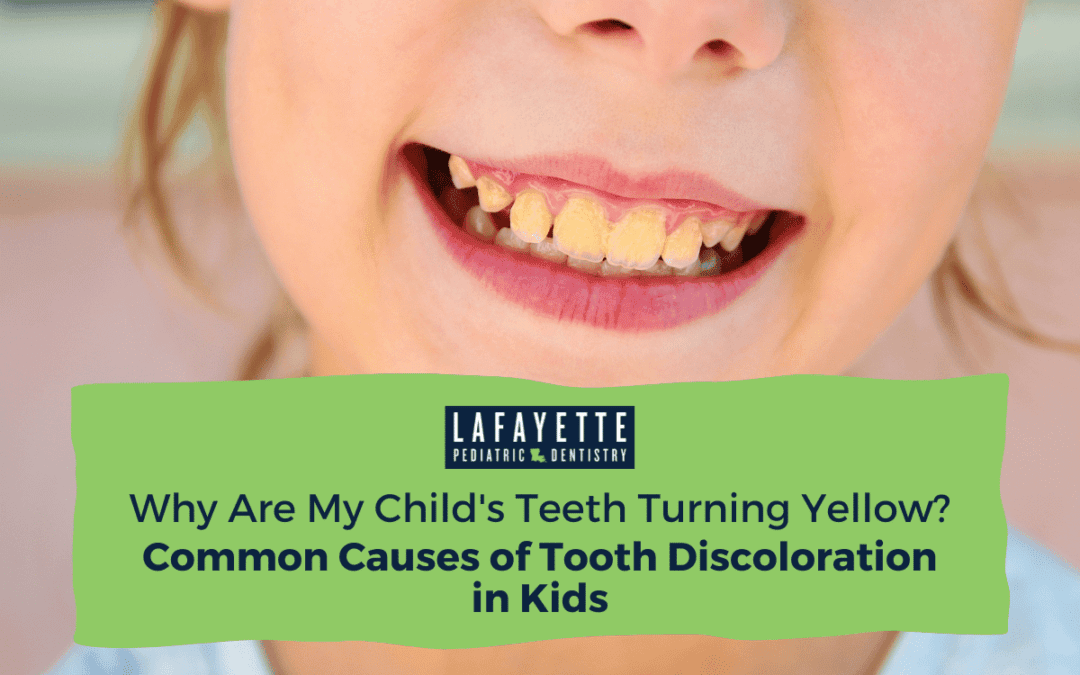At our Lafayette dental practice, we often meet concerned parents who notice changes in their child’s tooth color. You’ve been diligent about dental care, yet your child’s teeth seem to be developing discoloration or stains.
One day, your child’s smile looks perfectly normal, and the next, you spot a difference that wasn’t there before. It’s just natural to feel concerned, wondering if you missed something in your child’s dental routine.
Tooth discoloration in kids is more common than you might think, and there are several reasons why it can happen.
Types of Tooth Discoloration
There are two main types of tooth discoloration: intrinsic and extrinsic staining.
Intrinsic Staining
Intrinsic staining happens from the inside out. It starts in the deeper parts of the tooth and shows through the enamel. This type of tooth discoloration can be caused by dental injuries, some health conditions, or excess fluoride exposure during tooth development.
Intrinsic staining affects the deeper layers of the tooth, such as the dentin and pulp. Because it originates from within, intrinsic discoloration is often more challenging to treat.
Extrinsic Tooth Discoloration
Extrinsic staining is more like a coating on the outside of the teeth. It only affects the enamel, which is the hard, protective outer layer. This type of tooth discoloration is usually easier to treat since it’s limited to the surface.
Common Causes of Tooth Discoloration in Children
Tooth discoloration in kids can happen for various reasons, some of which are perfectly normal, while others may require attention.
Natural Occurrence
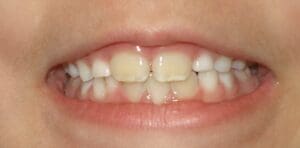 Did you know permanent teeth aren’t as white as baby teeth? This actually surprises many parents. During the ‘mixed dentition’ phase, when your child has both baby and permanent teeth, you might notice color differences.
Did you know permanent teeth aren’t as white as baby teeth? This actually surprises many parents. During the ‘mixed dentition’ phase, when your child has both baby and permanent teeth, you might notice color differences.
The front permanent teeth might look yellower compared to the remaining baby molars. Don’t worry, this is completely normal. Once all permanent teeth come in, the color will even out. This natural process is just part of your child’s dental development.
Enamel Hypoplasia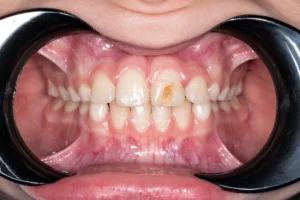
Sometimes, tooth enamel doesn’t form properly, leading to thin or missing enamel. This condition, called enamel hypoplasia, can cause yellowish or brown spots on the front teeth.
It’s more common in children with certain health conditions, such as hearing defects, intellectual disabilities, and cerebral palsy.
Read more: Dental Care for Children with Special Needs: What You Need to Know
Dental Trauma
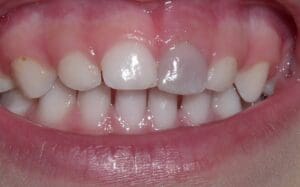 If your child bumps a tooth, it might turn dark yellow or gray over time. This discoloration often starts light and gradually darkens. It happens because the trauma can affect the tooth’s inner structure, and can sometimes lead to permanent bruising.
If your child bumps a tooth, it might turn dark yellow or gray over time. This discoloration often starts light and gradually darkens. It happens because the trauma can affect the tooth’s inner structure, and can sometimes lead to permanent bruising.
It does not necessarily mean the tooth is “dead”. Always contact your pediatric dentist right away after any dental injury, even if it seems minor to help prevent or minimize discoloration and other complications.
Decalcification
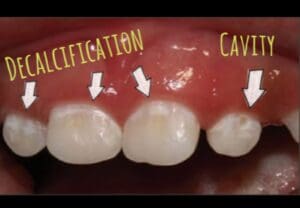
When teeth begin to deteriorate from lack of proper brushing or excessive sugar intake, the enamel undergoes decalcification.
This appears as white bands or spots on the tooth, and is a precursor to a cavity.
Fortunately, if caught early, progression into a cavity can be stopped if focus is re-directed on impeccable oral hygiene and decreasing sugar intake.
Excessive Fluoride Exposure
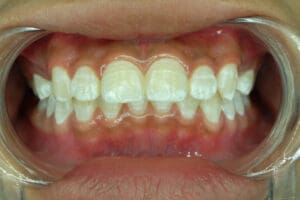
While fluoride is great for protecting teeth against decay, too much of it can cause a condition called fluorosis.
This results in white spots or streaks on the teeth. It’s rare and usually occurs only if a child is exposed to excessive fluoride.
If you notice this type of discoloration, your pediatric dentist may recommend cosmetic treatments to improve the tooth’s appearance.
Iron Supplements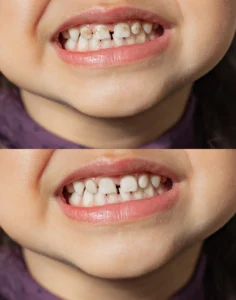
Children taking iron-containing multivitamins might develop dark stains on their teeth.
These stains can look alarming, but they’re usually just on the surface (what we call extrinsic staining) and don’t indicate any damage to the tooth itself.
These stains are harmless and can typically be removed during a professional cleaning at your pediatric dentist’s office.
Cavities: A Special Case
Dark spots or discolored areas, especially on the molar teeth, could be a sign of a forming cavity. 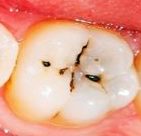
These teeth have lots of nooks and crannies where bacteria and food particles can hide. Regular brushing might miss these spots, allowing decay to start.
If you notice any unusual dark areas on your child’s teeth, especially the molars, it’s important to have a pediatric dentist check them out promptly.
Read more: Is Your Child’s Tooth Forming a Cavity? Spot the First Signs
Signs That Warrant a Dental Visit
If you notice any discoloration on your child’s teeth, it’s a good idea to contact your pediatric dentist for a proper diagnosis.
They can suggest ways to improve the appearance of affected teeth, which may include treatments to cover or remove the discoloration.
Keeping Your Child’s Smile Bright and Healthy
Regular brushing is your first line of defense against tooth discoloration. Pair it with daily flossing and a balanced diet low in sugary foods and drinks to help protect tooth enamel and keep your child’s smile bright.
At Lafayette Pediatric Dentistry, we’re committed to helping your child achieve and maintain a healthy, radiant smile.
We offer comprehensive dental care for children, including preventive services and specialized treatments like tongue tie correction, and emergency dental care when you need it most.
Schedule an appointment with our friendly pediatric dentists in Lafayette, LA today. Our team proudly serves families in Lafayette, LA, as well as Broussard, Youngsville, Breaux Bridge, and nearby areas.
